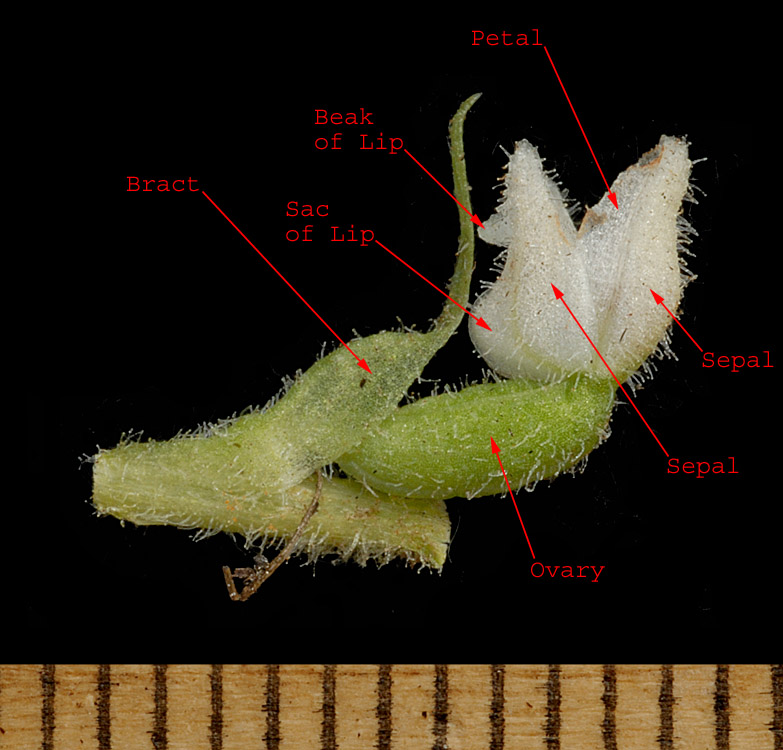 |
Repens: Answers
to key questions in Lilies, Irises & Orchids of Saskatchewan by
Vernon L. Harms and Anna L. Leighton leading to this species. The
answers are in the order you would normally work through the key.
 |
Leaf-blades
1-3 cm long, plain green or often with darker or lighter green veins;
scapes usually 10-25 cm high; sheathing bracts not glandular-pubescent
throughout, at least terminal half of uppermost bract lacking hairs and
glands; racemes 3-6 cm long; flowers 3.5-5 mm long; lip 2-4 mm long, the
base enlarged into a distinctly sac-like pouch, the tip acute, curving
downward at maturity; lateral petals and sepals (2.5) 3-4 (5) mm long;
anthers 1-1.5 mm long, blunt-tipped; rostellar beak 0.2-0.6 mm long,
shorter than stigma-body; widespread in the boreal forest region; NOT
[Leaf-blades 2.5-10 cm long, green with a whitish band along midrib;
scapes usually 20-40 cm high; sheathing bracts glandular-pubescent
throughout; racemes (4) 6-12 (20) cm long; flowers 8-10 mm long; lip 5-8
mm long, the base shallowly-inflated, the tip blunt, spreading or
slightly curved downward; lateral petals and sepals 6-8 mm long; anthers
2-2.5 mm long, abruptly acuminate-tipped; rostellar beak over 2 mm long,
longer than stigma-body; Cypress Hills only]
|
|
 |
Goodyera: Answers
to key questions in Lilies, Irises & Orchids of Saskatchewan by
Vernon L. Harms and Anna L. Leighton leading to this genus. The answers
are in the order you would normally work through the key.
 |
Plants
green, with at least some green leaf-blades, these sometimes early
withering or late developing; flowering stems green (pale pink to
purplish-red in Calypso bulbosa), bearing sheathing bracts in some
species; rootstocks not coral-like; capsules spreading to erect
(occasionally drooping when old); NOT [Plants non-green saprophytes
lacking leaf-blades; flowering stems yellowish to purplish-red or brown
(pale greenish-yellow in C. trifid), bearing sheathing bracts; rhizomes
rootless, coral-like in their branching; capsules drooping] |
 |
Flowers 3
or more in a spike-like inflorescence, small, often inconspicuous; lip
usually less than 1 cm long, but if longer, neither inflated nor broad
and flat; NOT [Flowers 1 to 2 per stalk (occasionally more in
Cypripedium reginae and C. montanum), large, showy; lip 1 cm long or
longer, either inflated or broad and flat] |
 |
Lip not
spurred; NOT [Lip spurred (spur short and bag-like in Coeloglossum
viride)] |
 |
Leaves
solitary or several, but not paired; NOT [Leaves 2, paired either at
base of stem or attached midway up stem] |
 |
Flowers
larger, lateral petals and sepals 3 mm long or longer; small bracts
present on stem above leaves; stems arising from fleshy roots or
creeping rhizomes; NOT [Flowers minute, lateral petals and sepals 2.5 mm
long at most; bracts absent on stem above leaves; stems arising from
pseudobulbs] |
 |
Leaves all
basal, thickish, evergreen, with midribs and veins often dark-lined or
white-reticulated; lip base inflated into a sac; lip tip narrow and
tapering; flowers conspicuously glandular pubescent; plants arising from
creeping rhizomes with slender roots; NOT [Leaves basal or attached to
lower stem, thin, not evergreen, uniformly green; lip base not inflated,
lip tip broad and rounded; flowers not conspicuously
glandular-pubescent; plants arising from clusters of thin to thick
roots] |
|

